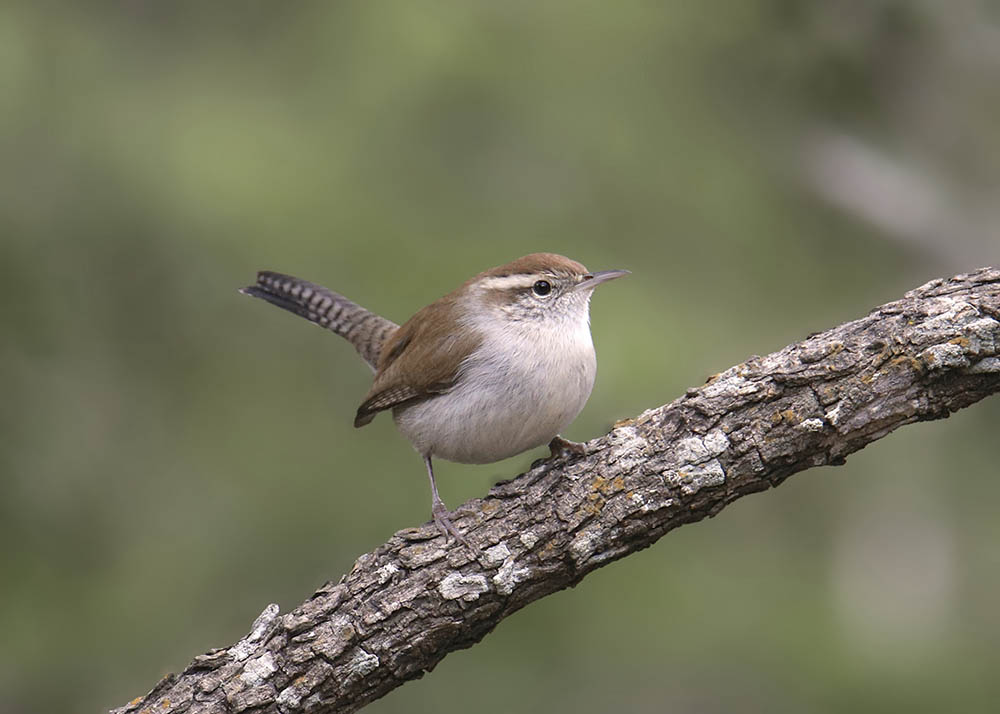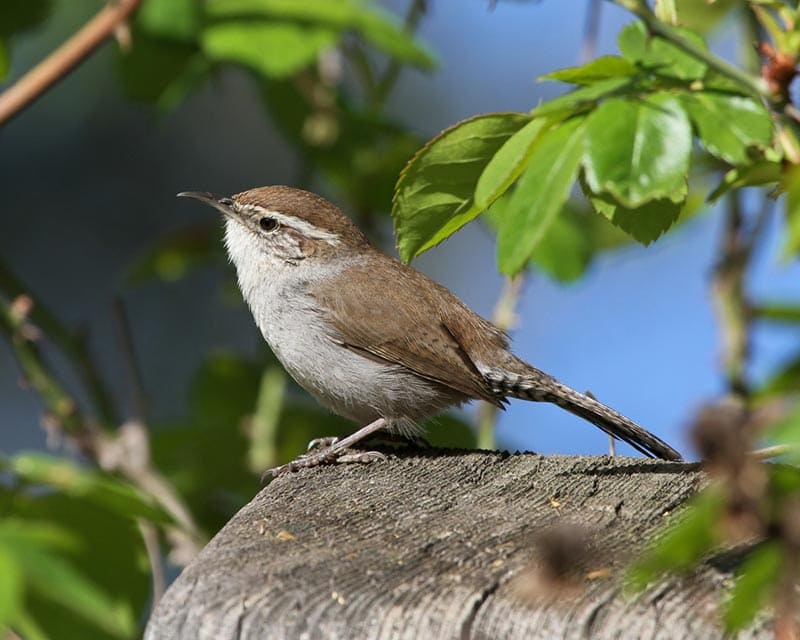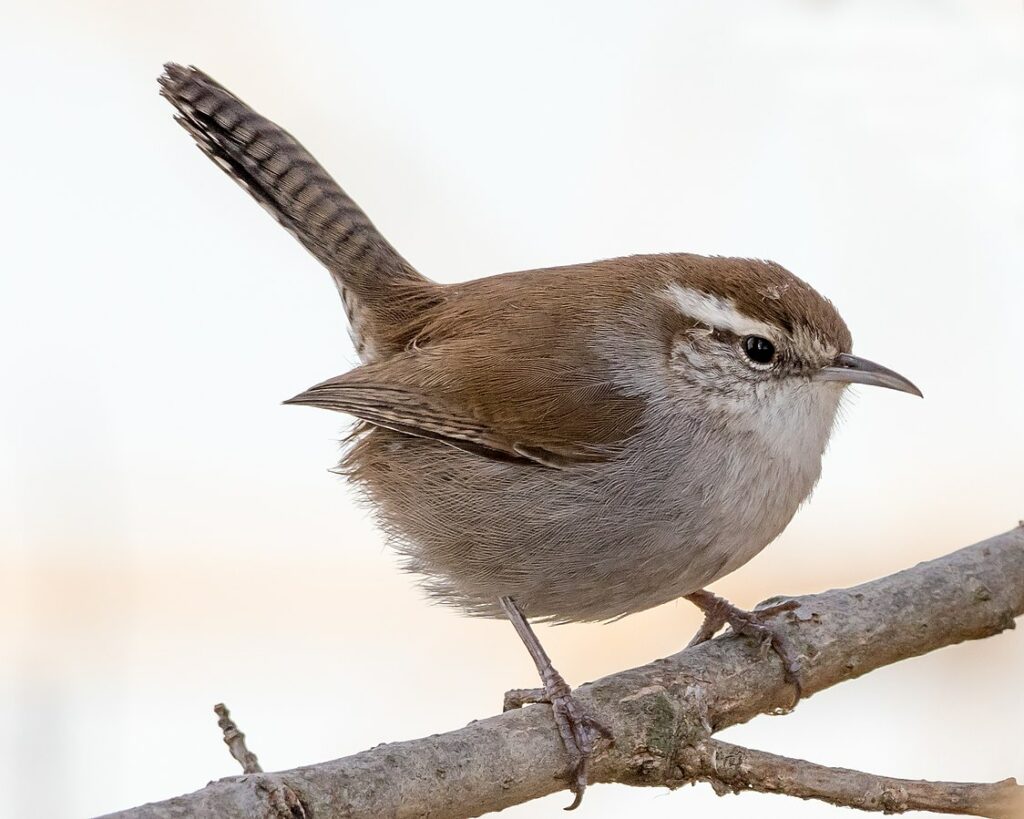Bewick’s Wren: Field Guide, Pictures, Habitat & Info
Last Updated on

You’ll often hear a Bewick’s wren before you see it. They are very vocal birds, whether attracting a mate, defending their space, or telling an unwanted visitor to get lost.
These birds are really common in much of western and central North America. However, even though they aren’t endangered, they have all but disappeared from eastern North America.
This article will explore how you can recognize a Bewick’s wren when you’re out birdwatching, where to find them, and how you can attract them to your yard.

Quick Facts about the Bewick’s Wren

| Habitat: | Open woodlands |
| Diet: | Insects |
| Behavior: | Foliage-gleaner |
| Nesting: | Cavity |
| Conservation: | Low concern |
| Scientific name: | Thryomanes bewickii |
| Lifespan: | Up to 8 years |
Bewick’s Wren General Description
Bewick’s wrens are considered medium-sized wrens. Size-wise, they are in between a house wren and house sparrow. Their long, slender bills have a characteristic slight downturn to them.
Typically, a Bewick’s wren is brown and grey. Their back, wings, and head are brown, and their chests, throats, and bellies are usually light grey. They also have a white stripe over their eye, almost like an eyebrow. And they have a long tail with black bars and white spots.
Bewick’s Wren Range, Habitat, Behavior, Diet & Nesting
Range
For many years Bewick’s wrens were found in much of Mexico, Canada, and the United States. But in recent years, the eastern North American wren populations have been declining. For example, in the United States, you likely won’t find a Bewick’s wren east of the Mississippi River.
Habitat
Typically, these wrens prefer open woodland habitats like mixed evergreen forests or chaparral-covered hillsides. When breeding, they like a mix of scrubby vegetation and woodlands.

Behavior
These wrens are known for their athleticism. It’s common to see them hanging upside down on branches in search of a crunchy meal. That and they will also forage through leaves and underbrush. Once in a while, they’ll even catch a meal while flying.
An interesting thing that Bewick’s wrens do is once they catch a bug in their beak, they crush it or shake it to kill it. Sometimes, they’ll even hit it against a rock or a branch before swallowing it.
Diet
Bewick’s wrens are insectivores, so their diet primarily consists of insects and their eggs or larvae. Some of their favorites are beetles, spiders, crickets, flies, and moths. However, they don’t exclusively eat insects. At times, they eat fruit, seeds, and other forms of vegetation.
Nesting
A Bewick’s wren typically builds its nest no higher than 30 feet above the ground. They are cavity nesters, so some common places for them to nest are abandoned woodpecker nests or vehicles, piles of brush, rocky ledges or cracks, and nesting boxes. Unlike many other birds, the male typically begins the nest building, then the female joins in.

How to Find the Bewick’s Wren: Birdwatching Tips

What to Listen For
Bewick’s wrens are known for being very vocal. Whether they’re looking for a mate or warning something to stay away. The harsh, scolding notes they sing with are common things to hear if you get close to them.
What to Look For
If you find them eating, you’ll likely see them on a high point perching while they eat. You can also find them darting around quickly from branch to branch. While mating, you may be lucky enough to see a Bewick’s wren wagging its tail back and forth, and sometimes it’ll even fan its tail feathers out.
When to Look
Like most other wrens, Bewick’s wrens are most active during the day. So, your best chance of finding them is anytime during the day if you’re visiting an area where they nest.
Attracting Bewick’s Wrens to Your Backyard: Tips & Tricks
Bewick’s wrens typically prefer open woodlands to urban environments. However, if they live in your area, there are a few things you can do to encourage them to visit your backyard:
- Plant native shrubs and bushes
- Incorporate wood piles into your yard
- Do a rewilding landscape
- Set up nesting boxes
- Have a water source like a bird bath
Bewick’s Wren Conservation: Is this Bird Threatened?
Currently, Bewick’s wrens are listed as “least concern” of being endangered and their populations are strong. However, there has been a significant decline in their eastern populations over the years. Changing climate is one potential thing that is threatening their numbers.

Final Thoughts
If you happen to live in western North America and near some open woodland areas, there’s a good chance you’ll be able to find Bewick’s wrens. And if you don’t live in a heavily populated area, it’s not hard to encourage them to visit your yard. You could even have them nest in your backyard with a little extra care in providing things they like.
Featured Image Credit: vagabond54, Shutterstock
Table of Contents
About the Author Shea Cummings
Shea Cummings is a passionate content writer who believes that the power of words is immeasurable. He leverages years of experience in various trades such as carpentry, photography, and electrical to bring his articles to life. His goal is to provide his readers with information that delights and informs. When he's not writing you can find him spending time in the outdoors or playing some Minecraft on the Xbox with his wife and two sons.
Related Articles:
10 Types of Hummingbirds in Arkansas (With Pictures)
8 Types of Hummingbirds in Nebraska (With Pictures)
5 Types of Hummingbirds in Idaho (With Pictures)
3 Types of Hummingbirds in Mississippi (With Pictures)
8 Types of Hummingbirds in Kansas (With Pictures)
5 Types of Hummingbirds in West Virginia (With Pictures)
5 Types of Hummingbirds in Ohio (With Pictures)
Where Do Nuthatches Nest? Nuthatch Nesting Habits Explained
